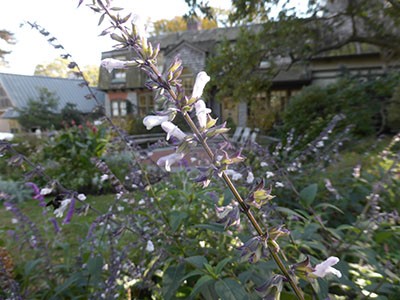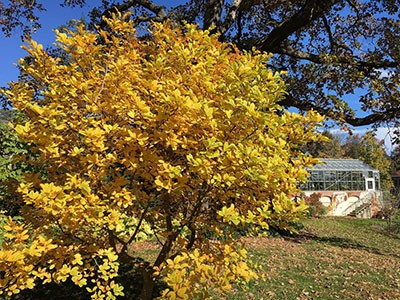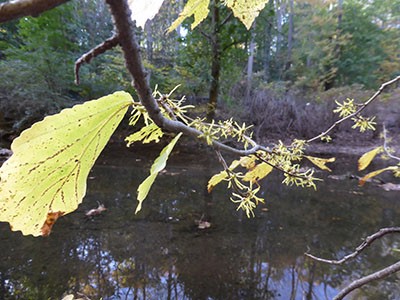Plants of the Week: November 7
 Salvia is the largest genus of plants in the mint family, Lamiaceae, with nearly 1,000 species of annuals, shrubs, and herbaceous perennials. Commonly referred to as sage, the genus is distributed throughout the Old World and the Americas. Salvia ‘Waverly’ is but one sage currently putting on a spectacular floral display. Flowers by the Sea, a purveyor of Salvia based in California, has this to say about the Waverly sage:
Salvia is the largest genus of plants in the mint family, Lamiaceae, with nearly 1,000 species of annuals, shrubs, and herbaceous perennials. Commonly referred to as sage, the genus is distributed throughout the Old World and the Americas. Salvia ‘Waverly’ is but one sage currently putting on a spectacular floral display. Flowers by the Sea, a purveyor of Salvia based in California, has this to say about the Waverly sage:
“This is a tender, woody shrub that may remain evergreen or a herbaceous perennial that dies to ground, depending on the winter temperatures where you live. First called “Mark’s Mystery White,” this long-blooming, sun-loving plant can tolerate some shade. It appears to be related to Mexican Bush sage (S. leucantha), but it’s likely we’ll never know all the details of its heritage. A pale pink to lavender blush adds delicate color to the white flowers of Waverly Sage, which are supported by plum-colored calyces. Its mid-green leaves are lance shaped and veined. Waverly Sage has a fountain-like form with long stems that rise up from the base and then arch downward. Height varies depending, once again, on local growing conditions. On our farm, it tends to reach about four feet high and six feet wide. However, it does well in a large container. Deer avoid this shrub, which is popular with butterflies, honeybees, and hummingbirds. Heat tolerant and drought resistant, it is a great choice for dry landscapes.” Photo credit: J. Coceano
 Magnolia isn’t a genus that comes to mind when thinking about good, reliable fall color. There are, however, a few exceptions. Magnolia x loebneri ‘White Rose’ is such an exception with brilliant yellow fall foliage. This seedling selection of Magnolia ‘Ballerina’ sports fragrant pure white flowers in early spring. Numerous, tightly bunched tepals give a look reminiscent of small gardenias or roses. A specimen, planted by the Swarthmore Class of 2015 can be seen behind the Terry Shane Teaching Garden near McCabe Library. Photo credit: J. Coceano
Magnolia isn’t a genus that comes to mind when thinking about good, reliable fall color. There are, however, a few exceptions. Magnolia x loebneri ‘White Rose’ is such an exception with brilliant yellow fall foliage. This seedling selection of Magnolia ‘Ballerina’ sports fragrant pure white flowers in early spring. Numerous, tightly bunched tepals give a look reminiscent of small gardenias or roses. A specimen, planted by the Swarthmore Class of 2015 can be seen behind the Terry Shane Teaching Garden near McCabe Library. Photo credit: J. Coceano
 You may catch a sweet and distinct scent walking along the Crum Creek at this time of year. As you scan the woodland it might be hard to visually pinpoint the source of the fragrance; competing hues and shades of yellow, gold, and orange mask the small but pleasantly pungent flowers of our native witch hazel, Hamamelis virginiana. This fall-blooming, deciduous shrub or small tree is found throughout the woodlands, forest margins, and stream banks of eastern North America. Typically growing 15-20’ tall with a similar spread in cultivation, this witch hazel can reach 30’ tall in its native habitat. Stem-hugging clusters of fragrant, bright yellow flowers, each with four crinkly, ribbon-shaped petals, appear along the branches from October to December. Photo credit: J. Coceano
You may catch a sweet and distinct scent walking along the Crum Creek at this time of year. As you scan the woodland it might be hard to visually pinpoint the source of the fragrance; competing hues and shades of yellow, gold, and orange mask the small but pleasantly pungent flowers of our native witch hazel, Hamamelis virginiana. This fall-blooming, deciduous shrub or small tree is found throughout the woodlands, forest margins, and stream banks of eastern North America. Typically growing 15-20’ tall with a similar spread in cultivation, this witch hazel can reach 30’ tall in its native habitat. Stem-hugging clusters of fragrant, bright yellow flowers, each with four crinkly, ribbon-shaped petals, appear along the branches from October to December. Photo credit: J. Coceano





No Comments